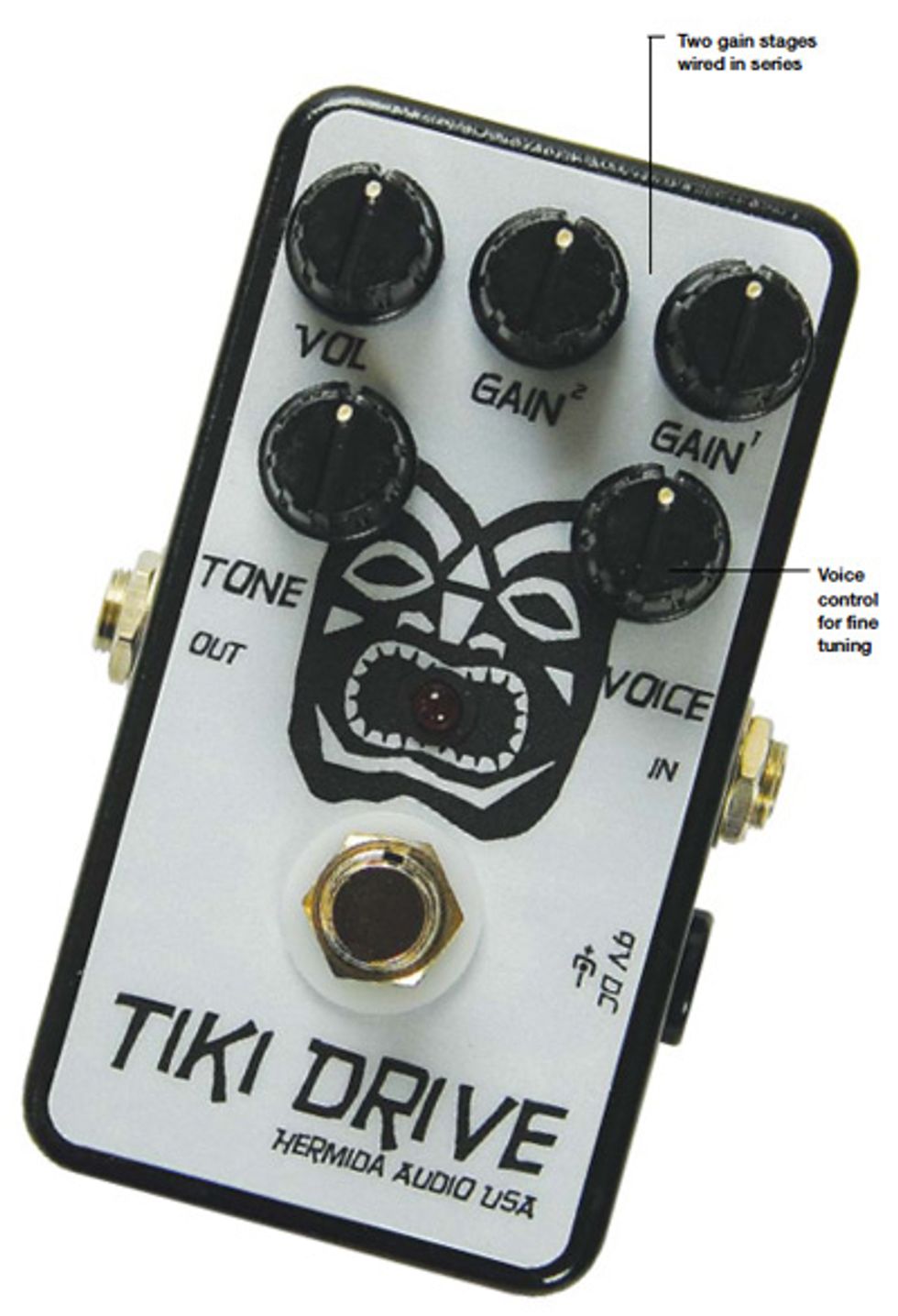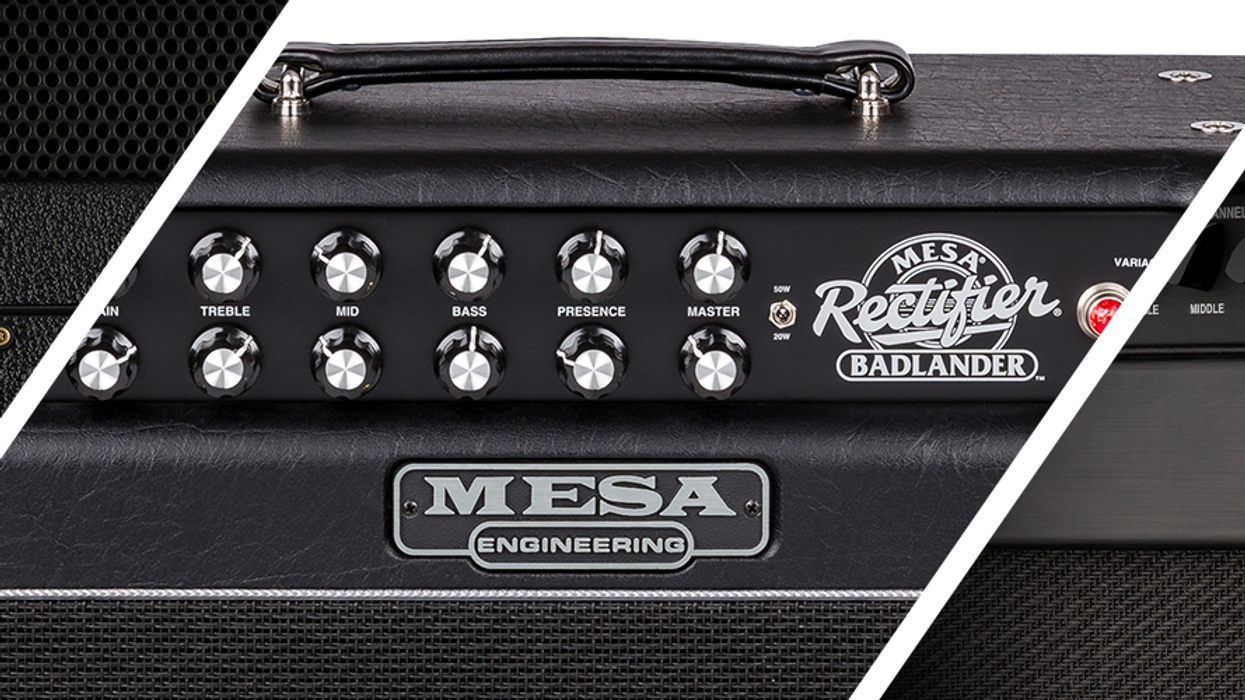 | |
| Download Example 1 Les Paul – crunch rhythm | |
| Download Example 2 Epiphone Sheraton - fuzzy , thick lead | |
| Download Example 3 Strat – high gain solo tone | |
| All clips recorded with a BC Audio No. 8 amp with an SM57 off-axis into a Chandler LTD-1 mic preamp (no eq). Recorded into Pro Tools through an Apogee Symphony I/O. | |
Even knowing that reputation, I was knocked flat by the Hermida Tiki Drive. It was designed with input from the Cars’ Elliot Easton and was built to satisfy his desire to color an essentially clean amp with multiple shades of overdrive and distortion. But it was also built to deliver extremely high-gain tones while retaining clarity, focus, and attack. It’s an ambitious agenda for one pedal, but the Tiki Drive pulls it off with little compromise.
Built to Be Flexible
The Tiki Drive control layout merits a little more attention than your average overdrive. Controls for Volume, a first and second gain stage called Gain 1 and Gain 2, Tone, and Voice are arranged in two rows on the top of the pedal.
The Gain 1 and Gain 2 are wired in series and voiced independently to give the pedal the potential to move from slightly overdriven to higher-gain, metal-style overdrive. The Voice control helps fine-tune the pedal for a given amp by manipulating midrange harmonic content.
Sweet Spots
To evaluate the Tiki Drive, I ran it into a BC Audio No. 8—an amp with beautiful clean tones—through an Eminence Governor 1x12 cab, as well as a late-’60s Marshall basketweave cabinet with original G12H-30s. I set the BC for a full, clean tone that didn’t break up unless hit very hard, then turned all five of the Tiki Drive’s controls to noon. The sound that leapt from the speakers was a classic hard-rock distortion with just the right amount of bite and crunch. But the sound was far from generic, and I particularly liked the way the pedal enabled me to work with the intrinsic touch sensitivity of my Tom Holmes 455 humbucker-equipped Epiphone Sheraton and explore this semi-hollowbody’s harmonic complexity.
Though twisting the Voice control back and forth didn’t produce a dramatic effect, the knob was very handy for shaving off a bit of top end or adding a slight bit of brightness to the signal. It was also useful for helping me find the sweet spot on my amplifier as it worked with the Tiki Drive and the Sheraton. And at a setting of about 1 o’clock, I found a perfect recipe that was neither too bright nor too dull.
One real surprise and bonus was the effectiveness of the Tone control, which adds a nice amount of sizzle within a frequency range that suggests a high presence knob. Cranking the Tone all the way yielded a sound that wouldn’t be a stretch to call Dumble-like.
The Gain controls are wired in series so they cascade into each other for more distortion potential, and the distinctive voice of each stage enables delightfully complex tones. Pegging Gain 1 gives the Tiki Drive some of the characteristics of a well-rounded fuzztone with a little spit on top of smooth distortion. Combining Gain 1 and 2 opened the gates to a world of exciting sounds ranging from vintage Marshall to extreme metal distortion. I was really impressed with how Gain knobs 1 and 2 worked with the Tone control to create heavily overdriven sounds that retained chime, clarity, and attack. Cranking Gain 1 and setting Gain 2 to noon generated an incredibly thick sound with sustain that lasted until I dropped the note.
Plugging in a Godin ICON Type 2 equipped with Duncan Convertibles, I switched to single-coil mode to investigate the pedal’s range with chimey and more Strat-like sounds. Here again, the Voice control helped me find the sweetest spot for the Godin and the No. 8 amp—this time favoring an almost fully clockwise position. It was great to be able to fine-tune the sound to get the most response out of the guitar, pedal, and amp. The Voice control clearly separates the Tiki from other overdrives. Indeed, you have to work to make this pedal sound harsh or abrasive.
When I played a Les Paul, a Hamer Korina Special, and a Guild Brian May through the Tiki Drive, each guitar remained true to its roots and retained its tonal character, whether I explored subtly overdriven settings or entered half-way-to- Armageddon distortion zones. For such a little box, the Tiki Drive offers a world of sounds.
The Verdict
Hermida has a real gem in the Tiki Drive. For one pedal to cover so many different overdrive sounds is mindboggling, and the Tone and Voice knobs are brilliant testaments to Alfonso Hermida’s commitment to refining the overdrive and distortion pedal concept. Its quiet operation and versatility makes this a definite keeper for me. In fact, it might be the only pedal I need for many studio sessions. The Tiki Drive is a true overachiever.
Buy if...
you want huge tonal and gain options that turn one amp into a thousand.
Skip if...
you’ve already got your favorite gain pedal.
Rating...
Street $229 - Hermida Audio Technology - hermidaaudio.com |






![Rig Rundown: Russian Circles’ Mike Sullivan [2025]](https://www.premierguitar.com/media-library/youtube.jpg?id=62303631&width=1245&height=700&quality=70&coordinates=0%2C0%2C0%2C0)

















